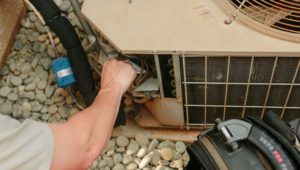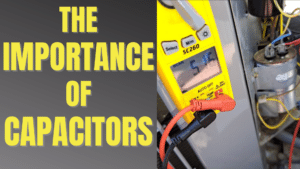Today we’re going to talk about troubleshooting a furnace pressure switch. I want to expand on our recent gas furnace troubleshooting series by going into each part of a furnace’s operation sequence. I’ll fill you in on what the pressure switch does and why it’s important. And to wrap things up, I’ll give you five easy things to check when you’re troubleshooting a furnace pressure switch. That’s coming up here on the Fox Family Heating & Air Blog.
First, I want to give fair warning to anyone watching this that is not already an experienced technician in the HVAC industry. This video is for educational purposes only. Fox Family Heating & Air does not recommend anyone other than a professional to start opening the furnace up and trying to diagnose the failure going on with your system.
There are high and low voltages that can shock a person. There are also lots of moving components that can damage body parts—namely, hands and fingers. The furnace also produces hot surfaces within the furnace compartments and around the housing, which can cause severe burns. An actual flame produced by the ignition and start-up of a gas furnace can cause severe burns and damage to a person or property.
The Furnace Sequence of Events
First, as a technician, you must know the sequence of events for a gas furnace to start properly. It’s very straightforward, and you should have this memorized before you can even consider being qualified to troubleshoot.
- Power to the furnace control board
- Thermostat signals the call for heat
- Inducer motor kicks on
- Pressure switch proves the inducer operates correctly
- Ignitor activates
- Gas valve energizes
- Flame pours across burners
- Flame sensor proves all burners are lit
- The blower forces air through the ducts
First, the Inducer Motor Starts
When a furnace begins a new cycle, the inducer motor is the first thing you should see kick on. 120 volts is applied through the wires coming from the control board. This starts the inducer motor for up to 60 seconds before anything else even happens. It’s a safety feature that creates a negative pressure or draft which purges the heat exchanger of any poisonous gasses, namely the byproducts of combustion. It makes the air inside the hollow tubes of the heat exchanger cleaner when the flame kicks on. When we have cleaner air inside the heat exchanger at the time of combustion, the furnace’s efficiency increases.
Next Up, the Furnace Pressure Switch Activates
Next, a safety device called a pressure switch activates when the diaphragm inside it recognizes the inducer motor’s suction or purging action. The pressure switch is a normally open switch that closes upon the manufacturer’s specifications for required negative pressure.
If the inducer turns on and is working normally, the furnace pressure switch should activate. There’s no time lag on this either. The inducer motor creates this draft quickly. Within 5 to 7 seconds in most cases – and the rest of the furnace starts up from there.
If the pressure switch doesn’t activate, the furnace will then shut down, wait a bit, and try again. If the pressure switch doesn’t close after 3 to 5 tries, the control board will stop sending voltage to the inducer motor, essentially locking it out from attempting it anymore.
You can tell the system is on some sort of safety lockout when the furnace’s fan (or blower) pushes room temperature air through the ducts and into your rooms. No one likes cool air blowing into their house when it’s heating season, so this happens to alert the occupant that the system isn’t working right, and they should call an HVAC company to come out and troubleshoot the system.
How to Troubleshoot a Furnace Pressure Switch
Let’s assume the inducer motor is running correctly. But the pressure switch doesn’t seem to be closing. Using your meter, you can trace the 24 volts coming from the control board, through the safeties, and on to the pressure switch. Place one lead on ground or a solid piece of metal attached to the furnace. Place the other on the incoming terminal of the switch. If you have 24 volts on the incoming terminal but not at the terminal leaving the switch, you can assume the pressure switch has not closed.
Another way of doing this is by testing with your leads across the two terminals. When the pressure switch is open, your meter will read 24 volts. When the switch closes, you’ll read 0 volts.Remember, the pressure switch doesn’t close until the inducer motor comes on and provides the necessary suction for the pressure switch to close. The required suction is listed on the pressure switch.
Furnace Pressure Switch Not Closing
When we’re troubleshooting a furnace pressure switch, we can do a few things. We can take our manometer and make sure the inducer motor is creating the vacuum by hooking up the meter’s hose directly to the collection chamber that the pressure switch tubing is connected. Take that pressure switch hose off and put your manometer’s hose on the same port.
Once you put the hose on and start the system up, the inducer comes on, and the manometer should start reading the induced draft as it begins to rise. This number on the meter needs to be greater than the number on the pressure switch. For example, suppose you’re testing a pressure switch that closes at -0.7 inches water column. In that case, the suction reading on the meter should be around -1″ wc. It could be less, it could be more, but it can’t be less than the number on the pressure switch. Meaning, if you’re reading -0.4″ wc, something is causing a low pressure reading.
Five Easy Things to Check
Let’s check out some of the things that could be going on here. Some of the more common reasons I’ve seen furnace pressure switches either fail or not close to allow the rest of the system fire up are:
- A clogged port on the collection chamber to the pressure switch
- An obstruction in the flue
- A diaphragm that’s ruptured or stuck
- The pressure switch hose is damaged
- The pressure switch hose has water in it
1. A clogged port on the collection chamber to the pressure switch
On the collection chamber, check to see if the port itself is clear of any calcium deposits, dirt, or other debris that would prevent air from flowing through the port. If there is, take a small wire — like some thermostat wire — and clean that port out. Whatever the substance is, it should be brittle enough to be scraped off, allowing the port to become clear.
2. An obstruction in the flue pipe
Remember, the inducer motor causes a draft to allow the gasses to be drawn out of the heat exchanger and into the flue pipe where it terminates outside the building—usually the roof. I have found that bees, wasps, and birds like to build their nests in and around the flue pipe. It’s not likely to happen during the winter, but for sure can happen over the summer. So, if the season is early and the furnace hasn’t been run yet, it’s good to check at the roof vent. It’s also not uncommon to see that the nest (or the bird) has fallen all the way down to the base of the pipe, where it meets the furnace.
3. A diaphragm that’s ruptured or stuck
Commonly, the pressure switch fails because the diaphragm inside the casing has become stuck or it has ruptured. Ruptured diaphragms can sometimes make a flapping noise. Stuck diaphragms just won’t budge on the required draft. Sometimes a little tap with your finger on the flat part of the casing will free the stuck part, and that’s great! But your switch is on borrowed time, and nine times out of 10, the switch will fail again. If I tell you it will fail tomorrow, it will last for years. If I tell you it will last for years, it’ll fail tomorrow. I recommend trying to convince the customer to replace the pressure switch now, so there are no surprises.
One way to see if the pressure switch is stuck open or closed is to breathe lightly into the hose leading to the switch. You’ll hear the diaphragm open and close. It doesn’t mean the switch will work properly, but it gives you more information to troubleshoot a furnace pressure switch.
Because pressure switches are almost impossible to rebuild, a new switch should be ordered.
4. A pressure switch hose is damaged
There have been diagnostic service calls that I’ve been on where I could tell the port was clean, the flue pipe was clear, the inducer motor was pulling a proper draft, and the diaphragm was functional. But, the pressure switch would still not send 24 volts across to the other terminal. Is the hose itself in good condition? Rats like to chew these hoses up and leave holes in them. Other hoses can become brittle and crack. Keep some extra tubing in your service van for cases like this.
5. A pressure switch hose has water in it
Another possibility is that water could be stuck inside the tubing to the pressure switch. Condensing furnaces send the flue gasses up the pipe, but latent heat will turn that gas into moisture that flows back down the flue pipe and into the inducer motor assembly. Remember that naturally flowing water flows downward. If there is a low spot in the hose leading to the pressure switch, you’ll find it won’t close. Try draining the hose by unplugging it from the port. Just be careful; there can be a lot of water in the hose so maybe have a bucket handy.
Installing a Furnace Pressure Switch
During the pressure switch installation, you want to make sure it’s mounted in the correct position. The pressure switch you took out was in a vertical position for a reason. Diaphragms don’t activate as easily when they must fight gravity. I once replaced a pressure switch with a universal and mounted it horizontally, parallel with the ground, and the switch failed a few days later. Of course, it didn’t happen when I tested it the day I installed it, but another tech had to come out and fix the problem a few days later.
I could have avoided this had I read the section in the installation instructions that said not to mount it in the horizontal position. I never did that again!
OEM switches will usually just screw right back into their old spot, but universals sometimes need to be creatively mounted. You may need to use a longer hose to get to the switch—another good reason to have an extra hose on your van. And make sure there are no dips in the hose, so water doesn’t accumulate, causing the switch to fail again in a couple of days.
Recap
So, just to recap. When a furnace begins a new cycle, the inducer motor is the first thing you should see kick on. A safety device called a pressure switch activates when the diaphragm inside of it recognizes the suction or purging action of the inducer motor. The pressure switch is a normally open switch that closes upon the manufacturer’s specification’s required negative pressure.
If the pressure switch closes normally, the rest of the furnace sequence of operation will continue. If the pressure switch won’t close, the system will go into safety mode, try a couple more times, and eventually just start blowing cold air in your room, letting you know something is wrong with your furnace.
Be patient and check the things we went over today before condemning a pressure switch. It could be one of a few things.
Thanks so much for stopping by, and we’ll see you on the blog next time.




















